Did you know that 76% of B2B buyers expect companies to understand their unique needs before presenting a solution? In an era where product features can be quickly replicated, how do you make your offering truly stand out?
Product and marketing leaders consistently wrestle with a critical challenge: breaking through the noise and creating meaningful differentiation in crowded markets. Despite having robust capabilities, many organizations struggle to articulate why customers should choose their solution over competitors—leaving potential revenue and market share on the table.
Competitive positioning isn't just about highlighting what you do; it's about strategically demonstrating the distinctive value only your solution provides. By crafting a precise narrative that resonates with your target audience's specific pain points and aspirations, you transform your product from another option to the obvious choice.
Competitive positioning is a strategic approach that defines how your product uniquely solves customer problems in ways your competitors cannot. At its core, it's about creating a clear mental space in your target customer's mind that distinguishes your offering from alternative solutions.
For B2B leaders, competitive positioning goes beyond simple feature comparisons. It's a strategic framework that articulates your solution's distinctive value through a combination of unique capabilities, deep market understanding, and precise alignment with customer challenges. Effective positioning transforms your product from a generic option into a specialized solution that speaks directly to specific business needs.
The true power of competitive positioning lies in its ability to shift conversations from price and features to value and transformative impact. When executed skillfully, it enables your organization to command premium pricing, attract ideal customers, and build sustainable competitive advantages that transcend incremental product improvements.
For B2B companies and SMBs navigating increasingly saturated markets, competitive positioning is not a luxury—it's a strategic imperative. The ability to clearly communicate your unique value determines whether potential customers see your solution as a game-changer or just another commodity.
Many businesses undermine their competitive positioning by:
Effective competitive positioning transforms your product from an interchangeable option to an indispensable solution that solves critical business challenges.

Transforming your competitive positioning from concept to strategic advantage requires a methodical approach. Follow these critical steps to craft a positioning strategy that resonates with your target market.
Conduct comprehensive customer research to uncover nuanced pain points and aspirations.
Systematically analyze your competitive ecosystem to identify whitespace opportunities.
Crystallize your distinctive market positioning into a clear, compelling narrative.
Continuously refine your positioning through strategic feedback and market testing.

Executing a robust competitive positioning strategy requires both strategic thinking and practical tools. The right resources can transform your positioning from theoretical concept to actionable market advantage.
Crayon
An AI-powered competitive intelligence platform that tracks competitor movements, helping you identify market gaps and positioning opportunities. Ideal for tracking digital footprints and real-time market shifts.
SurveyMonkey
Enables rapid customer research and positioning validation through targeted surveys. Helps gather nuanced insights about customer perceptions and unmet needs.
Klue
Competitive intelligence software that aggregates market data, allowing teams to build comprehensive competitive landscapes and inform strategic positioning decisions.
UserTesting
Platform for obtaining direct user feedback and market validation, critical for testing and refining positioning messaging across different customer segments.
Value Proposition Canvas
Developed by Alexander Osterwalder, this framework helps map customer needs against your product's unique capabilities. It provides a structured approach to identifying and articulating distinctive value.
Blue Ocean Strategy
Encourages creating uncontested market space by focusing on value innovation. This framework supports developing positioning that transcends traditional competitive boundaries.
Jobs-to-Be-Done Framework
Shifts focus from product features to understanding the fundamental problems customers are trying to solve. Helps create positioning that speaks directly to core customer motivations.
Three Horizons of Growth
Provides a strategic lens for positioning across different market maturity stages, helping businesses align positioning with current capabilities and future growth potential.
By integrating these tools and frameworks, B2B leaders can develop a sophisticated, data-driven approach to competitive positioning that goes beyond surface-level differentiation.
Mastering competitive positioning is not just about understanding your market, but strategically architecting your value proposition to resonate distinctively with target customers. By meticulously analyzing competitor landscapes, identifying unique differentiators, and continuously refining your strategic narrative, B2B leaders can transcend conventional market positioning and create compelling, differentiated offers that not only capture attention but drive sustainable competitive advantage. The most successful organizations view competitive positioning as a dynamic, iterative process—one that demands constant learning, agility, and a deep commitment to understanding evolving customer needs and competitive dynamics. Remember, in today's hyper-competitive business environment, your positioning is your strategic armor, capable of transforming market challenges into opportunities for meaningful differentiation and market leadership.